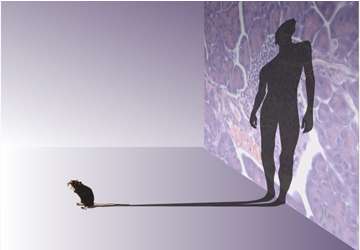Comparing mouse and human immune systems: Few differences charted in map to translate mouse findings to humans

(Medical Xpress)—It is a familiar note struck when authors conclude their reports on experiments conducted in mouse models: They suggest caution when translating their findings from mouse to human. A variation of this refrain can be heard when a small molecule that works in mice fails in human clinical trials.
There may be myriad reasons why results differ, and some challenges to the relevance of mouse models to human disease and therapy may be more anecdotal than evidence-driven, scientists say. But the need for better understanding the differences and similarities between human and mouse is clear. Genomic tools and analysis have opened the door to making comprehensive comparisons at a basic level that can inform future research in both mice and humans.
Scientists studying cell differentiation and function in the immune system set out to chart how the mouse and human compare in this area. Tal Shay, a postdoctoral associate in Aviv Regev's lab at the Broad Institute of Harvard and MIT, led a team from Harvard Medical School, the Broad and Stanford University who compared two large compendia containing transcriptional profiles—how genes are expressed—in human and mouse immune cell types.
The researchers found remarkable consistency between gene expression profiles in the mouse and human immune systems but also some instances of divergence. The majority of gene expression patterns—conservatively estimated at 80 percent—were the same in mouse and human. In addition, they suggest a role for transcriptional regulators that may guide some of the similarities.
Shay and her colleagues reported their findings in PNAS and also deposited their data and analysis in a web portal, which they hope will serve as a reference map for other investigators. Their work is part of the ImmGen Consortium, a collaboration of immunologists and computational biologists generating a complete compendium of gene expression and its regulation in the mouse immune system.
"We wanted to pinpoint where immune system genes and gene expression are different and where you should be very suspicious if something is found in mouse and likely to be translated to human," said Shay, who is a lead author of the paper. "We thought we might be able to map those places where the comparison is less robust, but we had a very hard time pinpointing convincing differences."
The researchers had to take extraordinary pains to make sure they were comparing only what was comparable—apples to apples. Not all mouse genes had a corresponding gene in the human data set, or they had more than one: There might be one gene in humans versus five in mice for smell receptors, for example. Sometimes differences were a matter of timing: Genes were activated earlier or later, depending on the species, said David Puyraimond-Zemmour, an HMS graduate student in immunology in the lab of Christophe Benoist and Diane Mathis and a co-author of the PNAS paper.
In all, they found several dozen genes in seven immune cell types that have different expression in 80 human and 137 mouse samples. Their conclusions are based on comparing data from the Differentiation Map—which measures gene expression in about 40 human cell types—and data from ImmGen, which does the same for about 200 mouse cell types. They did further analyses of gene expression when cells were activated in different states, such as responding to infection, based on a data set produced by Ei Wakamatsu and Ting Feng, postdoctoral fellows in the Benoist-Mathis lab. Shay also worked with the Differentiation Map data from the lab of Benjamin Ebert, HMS associate professor of medicine at Brigham and Women's Hospital and Dana-Farber Cancer Institute and an associate member of the Broad Institute, as well as from the ImmGen Project.
"What we assume most people will be interested in knowing is, if they are working on gene X, whether gene X has the same expression pattern in human and mouse immune systems," Shay said. "Most lineages have the same expression signature but some genes behave differently and we think it's important for why some things work in mice but not humans and the other way around."
Benoist, Morton Grove-Rasmussen Professor of Immunohematology at Harvard Medical School, said the continuing debate about the usefulness of mouse models in understanding humans "is often at the level of the emotional and not necessarily very informed." Wildly different experimental conditions—hugely varying doses or duration in clinical trials—make comparisons suspect, he said.
Having clear data that scientists can freely access will be useful, said Benoist, who is also a co-author of the PNAS paper.
"The value here is putting up signposts, signaling when the function of a gene in mice may not be relevant to humans," he said, referring to data and analysis from the work published in PNAS. "Because the differentiation and function of human and mouse lineages are highly related, there is the expectation of conservation, so it is important to know when inter-species inferences may be an issue. Mouse models are far too valuable to be jettisoned for pre-clinical exploration, but it is important to know when caution is needed."
More information: Shay, T. et al. Conservation and divergence in the transcriptional programs of the human and mouse immune, PNAS, February 19, 2013. systems, www.pnas.org/content/110/8/2946















